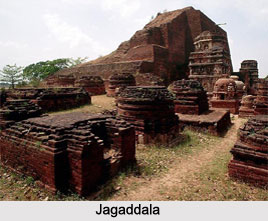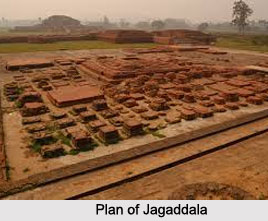 Jagaddala Mahavihara was a Buddhist monastery in the early medieval era. It was a seat of learning in Varendra, a geographical unit in present north Bengal, which is now in West Bengal and Bangladesh.
Jagaddala Mahavihara was a Buddhist monastery in the early medieval era. It was a seat of learning in Varendra, a geographical unit in present north Bengal, which is now in West Bengal and Bangladesh.
Foundation of Jagaddala Mahavihara
Jagaddala Mahavihara was founded by the later kings of the Pala dynasty, probably Ramapala most likely at a site near the present village of Jagdal. Some texts also spell the name Jaggadala.
Contemporary Monasteries with Jagaddala Mahavihara
A large number of monasteries were established in ancient Bengal and Magadha during the four centuries of Pala rule in North-eastern India. Dharmapala is said to have founded 50 viharas himself, including Vikramashila, the premier university of the era.
Establishment of Jagaddala Mahavihara
Jagaddala Mahavihara was founded toward the end of the Pala dynasty, most likely by Rampala. According to Tibetan sources, five great Mahaviharas stood out of Vikramashila, Nalanda, Somapura, Odantapuri, and Jagaddala. The five monasteries formed a network; all of them were under state supervision and there existed a system of co-ordination among them.
School of Vajrayana Buddhism
Jagaddala Mahavihara was specialized in Vajrayana Buddhism. A large number of texts that would later appear in the Kanjur and Tengjur were known to have been composed or copied at Jagadala. It is likely that the earliest dated anthology of Sanskrit verse, the Subhasitaratnakosa, was compiled by Vidyakara at Jaggadala toward the end of the 11th century or the beginning of the 12th century.
Decline of Jagaddala Mahavihara
Sakyasribhadra, a Kashmiri scholar who was the last abbot of Nalanda monastery and instrumental in transmitting Buddhism to Tibet, is said to have fled to Tibet in 1204 from Jagaddala when Muslim incursions seemed looming in the 12th century.
Excavation of Jagaddala Mahavihara
In 1999 Jagaddala Mahavihara was submitted as tentative site for inclusion on the list of UNESCO World Heritage sites. The United Nations Educational, Scientific and Cultural Organization reports that excavation in Jagaddala Mahavihara has revealed an extensive mound of 105 metres long by 85 metres, which represents the archaeological remains of Jagaddala Mahavihara that is seemed as an early medieval Buddhist monastery. The archaeologists found the terracotta plaques, ornamental bricks, nails, a gold ingot and three stone images of deities that depict Buddhists Gods like Tara, Jhambala, Atisha Dipankara, and Gautama Buddha.



















